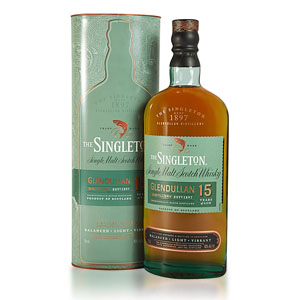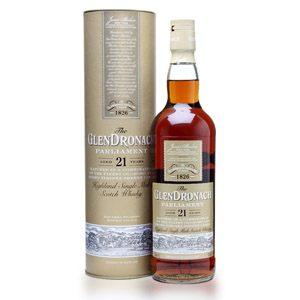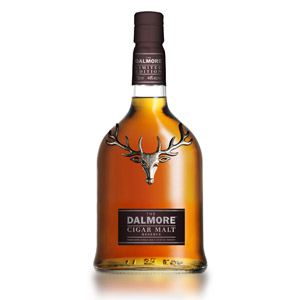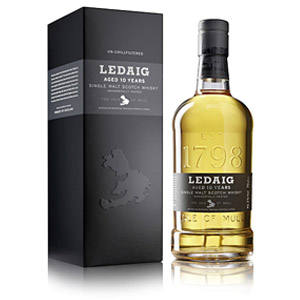Chieftain’s Rare Single Malt Scotch Whiskies is the independent bottling arm of Ian McCleod Distillers, storied blenders, bottlers, and now owners of the Glengoyne and Tamdhu distilleries. The company wisely saw the slow demise of the independent bottling industry as distilleries started hoarding their own surplus barrels to meet escalating demand across the world, and bought two single malt distilleries, a very smart diversification.
There is still independent whisky to be bottled, even if the pickings are slimmer, and some tempting things show up on shelves. Here, a Mortlach (one of my favorite distilleries, but hard to find) was distilled in September 1997 and spent some number of years in ex-bourbon before being transitioned to a Pedro Ximénez sherry butt to finish, for a total of 18 years in cask. Chieftain’s bottled the whisky in October 2015 at 46% ABV without chill-filtration or added color. This bottle is from Cask #91792, which produced 579 bottles for the US market. I bought it at K&L Wines in Redwood City for $99 and it sat in the back of my cabinet until I finally opened it recently. That’s all to say you’re not going to be able to find a bottle. Luckily, you’re not really missing out.
Even though $99 is a good price for an 18 year-old single malt, especially a sherried Mortlach, it didn’t take much tasting to conclude that this is the kind of thing that winds up on the independent market these days. It probably sat in a warehouse for a number of years before being chosen like the last scrawny kid being picked for dodgeball teams. (That was me, by the way.) The moral of the story is: Don’t expect to find gold under independent labels anymore. It can still happen, but you’re more likely to get deals than gems.
Nose: Dense, dark, sticky resin. Jammy and thick, with notes of cooked blackberry, plum/prune, fig, and not-quite-rancio notes of shoe leather, wood rot, and old wax. Not sweet, but there are notes of dense torte and fudge. Prominent nose tickle. A rest in the glass brightens the fruit a bit.
Palate: Thin body. More jam, although the palate is austere and flavors seem sparse. Red wine vinegar… old-vine Zinfandel… port wine reduction… coffee grounds…
Finish: Somewhat short. A dominant grape skin note, complete with red wine tannins and a bramble-like woodiness. Dusty. The finish happens quickly, leaving only the taste of old, wet attic behind. Clearly a sense memory from my own life, because that taste descriptor sounds downright daft. “I get a soupçon of wet attic.” Bah. Get over yourself, Noob.
With Water: Several drops of water increase the nose tickle but don’t seem to affect the aroma. The palate is a little more coherent, with fewer “dark” or resin-like notes and more fruity high notes. There is more caramel on the finish, and it might hold together longer. Try without water, and then add just a little to see how it changes for you.
Overall: Not as meaty or profound as some other Mortlachs that I’ve had. Luckily it is not noticeably sulfured, but the notes are eclectic and inconsistent, like a tapestry riddled with holes. A good example of the kind of thing that filters through the secondary market for single malt barrels without making a fuss, and probably would have performed much better as the sherry notes in a high-end blend. You aren’t going to find it anywhere, but at $99+ you’re not missing out.


About The Distillery
Mortlach has been a major component in the Johnnie Walker blends since 1923, and a majority of its output is used for blending. The distillery’s few single-malt releases are much prized by whisky drinkers seeking the house characteristic robust meatiness and affinity for sherry aging. Starting in 2014, owner Diageo has made a push to release Mortlach as a “premium” single-malt brand, with associated premium pricing and high-end packaging. The Speyside distillery itself was built in 1823, the first in Dufftown, and passed into and out of service (and through multiple hands) until bought by John Walker & Sons (later becoming Diageo) in 1923. Despite several improvements and a refurbishment Mortlach has six stills (three wash, three spirit) of all different sizes, shapes, and origins including a tiny spirit still named the “Wee Witchie” to which the meaty house character is attributed. Similar to Springbank, Mortlach employs a partial triple distillation sometimes called “2.7 times”. The distillery uses cold worm tub condensers, stills heated by indirect steam, six larch washbacks and a semi-lauter mash tun. Process water is drawn from springs that run off of the slopes of Meikle Conval, which collect into the Dullan Water which in turn joins the River Fiddich.








SN: I’d like to clear up some of the misconceptions you seem to have about independent bottles. First off, I’m sorry you didn’t enjoy this one. I am also a Mortlach fan and have concluded this particular distillate works better in ex-bourbon than ex-sherry. Like you, I learned this the hard way. Please know that independent bottles are typically hand-picked by the bottler, in this case the highly reputable Ian McCleod Chieftain line. The distillery doesn’t simply get to offload its duds on these companies. If you think about it rationally, Mortlach can easily rid itself of poor casks via blending them away with official Mortlach offerings that are effectively blends of hundreds of casks. Alternatively the casks can end up in one of many JWalker products. It is doing Mortlach and its valuable brand no favors at all by stamping its name on single casks sold by independent bottlers that are of poor quality. These casks are effectively marketing opportunities for the distillery. Mortlach (and other distilleries that allows their names to be included on the label) typically want their best casks available in this manner, not their worst. I can also attest that Chieftain’s has been very, very good to me. I have enjoyed utterly spectacular expressions of Bowmore, Glenburgie, and Linkwood. I just returned from London with 4 new bottles, 3 of which are independent (I simply couldn’t resist picking up an official Longrow 18yr for 90 pounds). I bought a 13yr Pulteney from Cadenhead, a 23yr Tormore from Blackadder, and lastly a 15yr Ardbeg from Ian’s Dun Bheagan line of independent bottles. In summary, don’t give up on independent bottles just yet. In fact, if you can swing past Binny’s in Chicago and pick up their Signatory 8yr Mortlach cask strength, I promise that will change your perspective toot sweet!
Hi DJ, thanks for the discussion! My impression of the independent market comes mostly via the experiences related by David when he worked at K&L over the last few years, from both his blog and in conversations with him. He had extensive access to independent warehouses in Scotland, and repeatedly noted a downward slide in available quality paired with an exponential increase in wholesale cost. Some cherry casks are still there, but now the bottlers want insane prices that retailers can’t justify to their customers. So, rather than offer the same distillery with the same age for three times the price, they are settling for inferior or immature casks for the same price. There are lots of reasons for this, but the primary one is probably the withholding of the best casks for offical bottlings which are now seeing much higher demand than 10 years ago. Simultaneously all the leftover “good stuff” isn’t around any more. The independent market was birthed on the surplus of over-aged casks that were sitting around, accruing tax burden, after the “whisky loch” of the 1980s. There are no more of those casks sitting around, and so warehouses only have the dregs left, because all the younger cherry casks are sold quick (and often young) to meet demand. It’s not a good market environment for independent bottlers, and (I think) it shows.